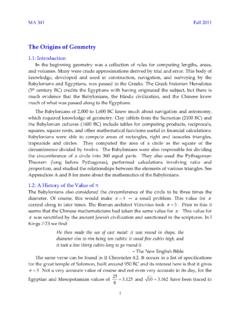Transcription of UV, VISIBLE, AND INFRARED SPECTRAL EMISSIONS IN …
1 UV, visible , AND INFRARED SPECTRAL EMISSIONS IN hybrid ROCKET PLUMES. M. Keith Hudson, Robert B. Shanks, Dallas H. Snider, Diana M. Lindquist, Chris Luchini, and Sterling Rooke Department of Applied Science University of Arkansas at Little Rock 2801 S. University Little Rock, AR 72204. Abstract A survey was made of the SPECTRAL EMISSIONS from a 2 x 10 inch labscale hybrid rocket motor system. The EMISSIONS in the Ultraviolet- visible (300-750 nm), Near INFRARED (750-1100. nm), and Mid INFRARED (2-16 m) regions were studied. Baseline EMISSIONS were found to consist of the sodium and potassium atomic lines, present due to the use of silica phenolic insulators, and the C2, OH, and CH combustion bands. Doped fuel studies were performed, using hydroxyl-terminated polybutadiene (HTPB) fuel mixed with metal salts to introduce emitters into the plume.
2 Metals studied included manganese, nickel, cobalt, copper, and iron. Iron was studied in both the II and III oxidation states. Manganese was also used to study the effect of concentration, and indicated that plume emission is quantitative, giving linear output for the range 5 to 40 ppm. Overall, the labscale hybrid was found to offer a stable system for plume spectroscopy, whether for direct studies of the hybrid type rocket, or for use in plume simulations of other propulsion systems. Introduction The hybrid rocket motor is of interest to the aerospace community for several reasons. Two of these, the possible use of hybrids as boosters and their potential usefulness as a plume simulator for other rocket systems, particularly solids, indicate the need for a thorough survey of their spectroscopic EMISSIONS .
3 For potential use as boosters, which has been discussed as possible alternatives to the current Space Shuttle Solid Rocket Motors (SRM), hybrids must be evaluated as to base heating effects, which are related to total IR EMISSIONS . The hybrid also appears to be an excellent motor system to use in ground based testing, especially for the general development of optical monitoring and other measurement techniques. A properly designed system, built from the ground up for these types of applications, offers an attractive and safe alternative to the use of solid or liquid propellant This paper reports the results of a SPECTRAL study of such a hybrid system. Atomic Emission Spectroscopy An atomic emission system basically consists of a source into which a sample can be introduced, a wavelength selector, and an optical detector.
4 The system used in this study is typical of those used for most emission experiments, but the source of EMISSIONS , a labscale hybrid motor, is different in several ways from those normally utilized. 1. As a base for comparison, the ideal atomic emission source has the following characteristics: 1. Complete atomization of all elements. 2. Controllable excitation energy. 3. Sufficient excitation energy to excite all elements. 4. Inert chemical environment. 5. No background. 6. Will accept solutions, gases, or solids. 7. Tolerant to various solution conditions and solvents. 8. Simultaneous multielement analysis. 9. Reproducible atomization and excitation conditions. 10. Accurate and precise analytical results. The hybrid rocket plume does provide a high energy source for the atomization and excitation of the elements involved.
5 The plume temperature has been measured to be approximately 2500-2700 degrees C, which is about the same as a hydrogen-air The temperatures in the combustion chamber are even higher, on the order of 3000 degrees C, providing more energy for the atomization process. The combustion stoichiometry is set to be fuel lean, which normally should provide lower background EMISSIONS . Rocket plumes in general then do supply an environment which is capable of good atomization and excitation, and can provide these to solids liquids or gases presented to the combustion chamber. Also, the motor control system allows precision metering of the oxidant, rigidly setting the operating point of the motor when fired. This renders good reproducibility in firing conditions, which, along with fuel dopant seeding homogeneity, results in reproducibility between firings.
6 However, it is obvious that a rocket plume falls short on several of these characteristics. Since the only method currently available for sample introduction is doping of the fuel grain, this limits us to metals, metal salts, or other solids, which then must not react with the polymer fuel while curing. hybrid motors display a significant amount of particulate matter in the plume, therefore, there is a component of blackbody type background radiation. The plume is exposed to the atmosphere, which is not an inert chemical background, but allows additional oxidant to react with exhaust gases. Characteristically, hybrid motors have an inherent tendency to pressure oscillations, on the order of 20-60 ,4 This causes fluctuations in plume intensity.
7 However, these fluctuations can normally be averaged or integrated out in the detection process, when using the "standard" atomic spectroscopy PMT or array detectors. Experimental hybrid Rocket Facility A hybrid rocket testing facility, complete with a computer control and data acquisition system, was designed and constructed for spectroscopic studies of the hybrid rocket motor plume and its use as a simulator for solid and possibly liquid motor systems. This facility has been described in another paper,5 but certain aspects will be discussed here since they affect 2. spectroscopic data collection. The hybrid rocket motor used in this study was a two by ten inch system, capable of firing at pressures to approximately 500 psi. It was fitted with pressure and temperature transducers to record these parameters with respect to time; during startup, run, and shut-down.
8 Pressure data was collected at 1000 Hz and is of particular interest since it indicates any transients or unusual conditions present during a firing. This pressure data was recorded and presented in such a form as to allow ease of utilization with data from the various spectroscopic systems employed in the study. Also, the hybrid motor was set up to allow full access to any particular point in the plume for SPECTRAL study. This was particularly important when using spatial imaging systems, such as standard video and IR thermal units. Instrumentation Two systems were used for SPECTRAL monitoring of the ultraviolet and visible SPECTRAL regions. A Princeton Applied Research Optical Multichannel Analyzer (OMA) Model III, which included a .33 meter ISA Spectrograph, was used in all of the firings studied.
9 This unit was used as a high resolution instrument, in a layout similar to previous Slit width was set at 12. micrometers and a 5 meter fiber optic was used for light collection. Another system, assembled in our laboratory, was used in many of the firings. This unit included a Spex Model 270M. Spectrograph using a Reticon 1024S linear array detector in the focal plane and a 486-33 PC. computer set up to control the array and collect This system was used in a lower resolution mode, monitoring both lines and bands, by setting the slit width at 100 micrometers. This instrument was placed in close proximity to the plume under study, using a single lens for light collection. For IR SPECTRAL monitoring, a Midac FTIR Emission Spectrometer with 2-16 micrometer SPECTRAL response mercury cadmium telluride (MCT) broadband detector was used.
10 The spectrometer was fitted with an adjustable iris at the entrance aperture to limit the amount of light entering the unit. The FTIR used a 486-33 portable PC computer for data collection and storage. A separate 486-50 PC computer was used to analyze this data, as it provided greater display versatility. Software was written in house to control this instrument and provide data display and manipulation capability. Further IR monitoring was performed with an Inframetrics Model 600 IR. Camera. This system was used for thermal imaging of the rocket chamber, nozzle, and plume. Materials Fuel for the hybrid motor used in these studies was hydroxyl-terminated Polybutadiene (HTPB), using Desmodur N-100 or similar isocyanates for curatives. Standard tanks of industrial grade oxygen were used as the oxidant in all studies.






